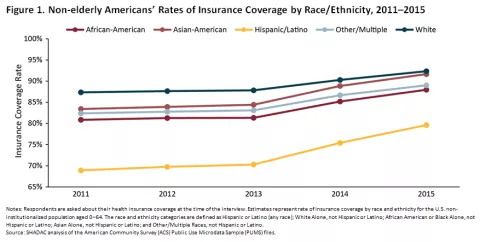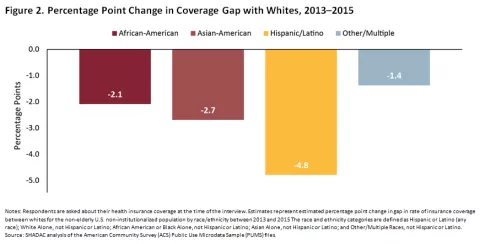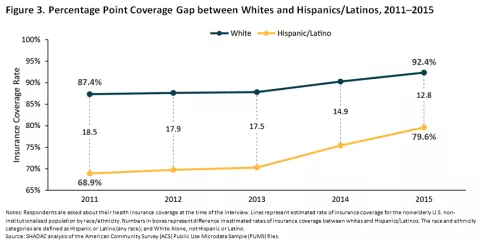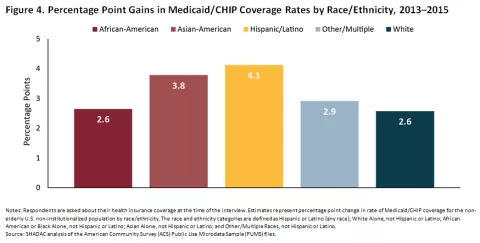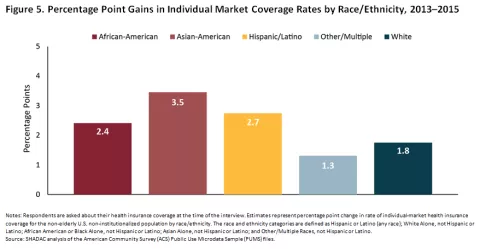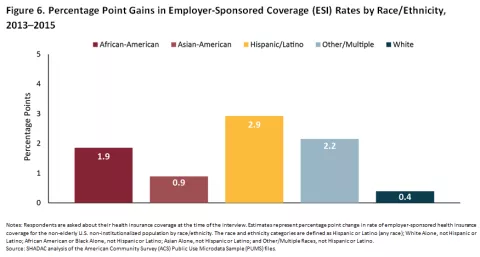The content below is cross-posted from The Gender Policy Report from the Center on Women, Gender, and Public Policy at the University of Minnesota Humphrey School of Public Affairs.
In 2014, the Affordable Care Act (ACA) expanded Medicaid and established health insurance exchanges for people to purchase private health insurance with subsidies. This led to significant gains in health insurance. Between 2013 and 2015, the rate of health insurance among non-elderly Americans increased 5.8 percentage points, and an estimated 17.6 million more non-elderly Americans had health insurance.
Gains in health insurance were particularly strong for groups that have had historically high rates of uninsurance, such as people who identify as Hispanic or Latino. If the ACA is repealed and replaced by a Republican health care reform bill, it is widely expected that these coverage gains will erode or be lost entirely. Previous posts to the Gender Policy Report have focused on the impact of the Affordable Care Act (ACA) and its possible repeal on fertility among Latinas, on women’s health care and coverage, and on women and LGBTQ individuals. In this post, we examine gains in health coverage by race/ethnicity with an eye to the potential loss in coverage if the most recent Republican plan[1] to repeal and replace the ACA were implemented. This post draws on SHADAC’s analysis of the National Health Interview Survey and is limited to non-elderly adults (aged 0–64).
Hispanics/Latinos, Asian Americans, and African Americans have had the largest gains in coverage since ACA implementation
The populations of Americans identifying as Hispanic/Latino, Asian American, or African American experienced the largest increases in insurance coverage in the period after implementation of the Affordable Care Act in 2013. Rates of coverage had been stable before 2013.
The population of Americans identifying as Hispanic or Latino had the lowest rates of insurance coverage before the ACA and the largest gains in coverage after ACA implementation. After remaining stable from 2011 to 2013, rates of insurance coverage among Hispanics/Latinos increased by 9.3 percentage points, meaning 6.3 million more non-elderly Hispanics/Latinos had insurance coverage in 2015 than in 2013. Asian Americans and African Americans also gained health coverage under the ACA with increases in rates of insurance coverage of 7.2 and 6.6 percentage points, respectively.
The gap in coverage rates between populations of color and whites narrowed historically under the ACA
As shown in Figure 1, all groups experienced increases in rates of coverage. This increase in coverage resulted in a historic narrowing of the gap in coverage between whites and populations of color between 2013 and 2015, with all represented racial/ethnic groups experiencing a reduction in the coverage gap (Figure 2).
The gap between Hispanics/Latinos and whites narrowed the most—4.8 percentage points between 2013 and 2015—though the rate of coverage among Hispanics/Latinos is still lower than among other racial/ethnic groups (Figure 3).
Hispanics/Latinos, Asian Americans, and African Americans gained coverage through programs cut most significantly under ACA repeal and replacement
The ACA’s largest impacts on health coverage came through its expansion of Medicaid coverage to low-income childless adults in 35 states and the creation of tax credits to help low- and middle-income families purchase individual-market coverage. These programs contributed substantially to the narrowing of the gap in health coverage between populations of color and whites.
The recent Republican plan to repeal and replace the ACA makes dramatic cuts to the Medicaid program and its expansion and substantially reduces the size of tax credits to help families and individuals purchase individual-market coverage. If implemented, these changes would likely have a disproportionate impact on individuals who gained health coverage through these new programs or currently rely on the pre-ACA Medicaid program that the Republican bill cuts, many of whom are people of color.
Since 2013, non-elderly Latinos and Asian Americans experienced gains in Medicaid coverage of 4.1 and 3.8 percentage points, respectively. These gains in Medicaid coverage are most likely the result of the ACA’s Medicaid expansion, though some may also come from new enrollment in traditional Medicaid programs (i.e. the “welcome mat” effect). Groups like Latinos and Asian Americans that made larger gains under Medicaid expansion are potentially more vulnerable to losing coverage if that program were to be rolled back as it is in the recent Republican bill (Figure 4).
The recent Republican health reform bill repeals the ACA’s income-based tax credits and replaces them with flat, age-based tax credits. This change would make individual-market health insurance far less affordable for low- and middle-income individuals and families, many of whom are people of color. Non-elderly Asian Americans, Latinos, and African Americans would be more vulnerable to losing coverage under the recent Republican plan, since these groups experienced larger gains in individual-market coverage than whites or individuals identifying with multiple races or with some other race (Figure 5).
Further, while non-elderly Latinos, African Americans, and the population of individuals identifying with multiple or some other racial group experienced significant gains in employer-sponsored health coverage (ESI), they are less likely than whites to have ESI, one of the sources of coverage least affected by the Republican plan to repeal and replace the ACA.
A repeal of the Affordable Care Act would likely widen the gap in rates of coverage between populations of color and whites
The longstanding gap in rates of health coverage between whites and populations of color narrowed substantially since implementation of the ACA (Figure 2). Programs like Medicaid expansion, the health insurance exchanges, and tax credits for purchasing coverage contributed significantly to the narrowing of that gap. If these programs were repealed, defunded, or otherwise rolled back—as they are under the recent Republican plan—individuals who benfited from these coverage expansions would likely lose their coverage, again widening the gap in health coverage rates between whites and populations of color.
[1] All references to the Republican plan to replace the Affordable Care Act refer to the House Bill known as the American Health Care Act as it existed when it was pulled from consideration on the House floor March 24, 2017 after failing to garner the necessary support to pass.

